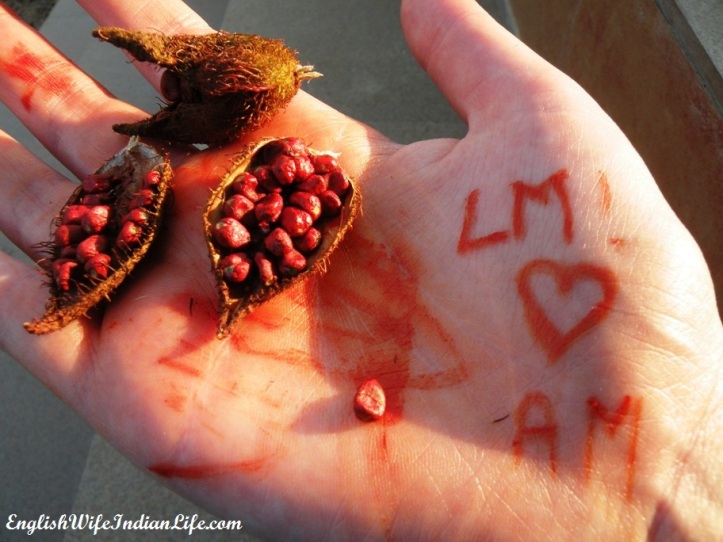On Sunday we left the city, drove into tiger inhabited jungle, got lost for a while, then found the botanical garden we were searching for. A beautiful farm forty kilometers from Nagpur, full of flowers, plants, vegetables and herbs with medicinal properties. A group of us went (including my mother-in-law, husband and Alfonso) to see the plants, have lunch produced by the garden and learn about some of the hundreds of species which grow there. Alfonso probably had the most fabulous time of all. He was allowed to run around, play with our friend’s children (who luckily love him as much as he loves them) and hide from the resident kitten!

The medicinal properties of plants is of particular interest to me as this was the subject of my master’s thesis (pharmacognosy). The study of natural products was my favourite module during my pharmacy degree, the tour was in Marathi so I spent my time soaking up nature and reading the information the plants were (thankfully) labeled with.

The plant I found most interesting was Bixa orellana, the sindoor tree! I’ve written about sindoor several times, probably to excess, but the red powder plays a huge role in Hindu ceremonies, symbolism and general auspiciousness. So, to see a sindoor type substance spring from Indian soil was, in my opinion, beautiful! Holding the small pods of ruby red seeds, I saw a flash of sapphire blue as a spectacular bird flew from one tree to another. I sometimes forget how stunning the colours of nature are, I need to get lost in the jungle more often!


I discovered the colour from the pulp which covers the seeds is a really effective dye (used commercially as a food colourant, along with several medicinal uses), as even after scrubbing with soap and water, I still had my graffiti on my hands! I guess it could also be used as mehendi (henna)!

Some brands of commercial sindoor still containing toxic elements such as mercury and lead, so using the pulp from the sindoor tree seems like a natural and safer alternative (I also created a sindoor recipe a couple of years ago using turmeric and calcium hydroxide)!
I wonder if I can grow a sindoor tree on my terrace?
***
Check out my Instagram for daily updates and discussions!

Just got back from India Lauren so I was very eager to read your post ! I had no idea there was a Sindoor tree, looks like a lovely place to visit how fun ! Its always nice to have a field trip in the countryside. Definitely doing some sight seeing next visit, Ajanta and Ellora caves are on my list.
LikeLike
Hey Tracy! I hope you had a fabulous Christmas in India!!
I missed out on the caves, I’ve even been to Aurangabad but we didn’t have time to visit (attending a wedding there)!
I hope you are well! Take care xx
LikeLike
What are the medicinal uses of the sindoor tree? I very nearly did a degree in phytotherapy before I changed careers completely but like you have kept up my interest in healing with plants. I often bring back ayruvedic remedies to the UK that you can’t get here and always have a pot of bramhi on my desk at work! I think knowledge of plants for healing as medicine and in cooking is something that should be taught to everyone and certainly as part of conventional medical degrees.
LikeLike
There are many different ones in different cultures! I found this website really interesting:
http://www.sacredearth.com/ethnobotany/plantprofiles/achiote.php
Hoping you are well! Sending love xx
LikeLike
Hi Lauren,
I have been reading your blog from last 1 year or more.This is the first time I thought of writing you.
Sindoor plant is used for making homemade sindoor. You can use it to make sindoor for yourself. My family use it to make sindoor for using in temples and prayers.You can use turmeric powder and sindoor plant(you can even get it from market).Mix it, grind it and use it. 100 % natural, safe and you will get perfect red colour.
LikeLike
Hey Rashmi,
Lovely to hear from you!!
So lovely to hear you use this plant to make your own sindoor!!! Wow! I definitely want to get a tree of my own now!
Thanks again for contacting! Lots of love xx
LikeLike
HAH! I did my master’s thesis on pharmacognosy also- the effects of side stream marijuana smoke!
I love botany too. I have a huge garden here in Nepal & just purchased the most enormous 11 volume botany guide to the Himalayas.
LikeLike
No way! That’s great!
Mine was on flavonoids, I spent a lot of time with grapefruit!
I bet that is a gorgeous book! Would love to know more about your Nepali garden! xx
LikeLike
My grandmother and mother used to make ‘sindoor’ fpr puja and tilak using haldi (turmeric), lemon (home grown large desi variety) and other concoctions, possibly suhaga (borax) and lime, as I read from some of the sources.
LikeLike
Lovely!! 😀
That is the way I have made it before! I hope you are well 🙂
LikeLike
i wondered how sindoor powder was made…is it also used as a paint for bindis? I use the sticker-bindis but i was really wondering what else(more paint like) could be used. what do you use for your bindi?
LikeLike
I use a variety of bindis, liquid and stick on, my mother-in-law always uses the liquid. My favourite type of bindi is the chandra kor, I think it suits me and I love that it’s part of my husband heritage (Marathi)
I hope you are well xx
LikeLike
Beautiful! I love places like these. India has so many interesting herbs and spices and plants.
LikeLike
Yes, I really want to discover more!
🙂
Hope you guys are well xx
LikeLike
A belated Happy New Year to you! What an interesting start to the year – I do love visiting parks and gardens and learning about the history and uses of plants. I never realised there was a sindoor tree!
LikeLike
Thank you, Sakthi!
It’s really a lovely experience to discover nature! I hope you are well and having a Fab January! xx
LikeLike
Lauren!! :)) hiiii
Completely unrelated question, but I just clicked on your make your own sindoor post and I LOVED your eye liner :). Do you mind telling me which brand you use, also do you apply an eyeshadow base on your eye before applying your eye liner?
Thaaanks 🙂
LikeLike
Hey Divya,
It’s a liquid eyeliner my mum bought me whilst she was living in Kuwait. It’s Bourjois Paris, Liner Pinceau 16 hours 😀
I usually use powder on my face, but Rimmel (and good lighting 😉 )
I hope this helps xx
LikeLike
I just never knew that sindhoor comes from seeds. They probably have some interesting scientific explanation behind them their use too. It could be good for the skins and such.
LikeLike
You learn something new everyday 😀 xx
LikeLike
Hi Lauren! Happy New Year to you guys! This tree is native to Central/South America, we use the red pods in cooking and call it “achiote” or “annatto”. It was also used as body and hair dye by local tribes and as a source of ink for writing. Cheddar cheese gets its orange yellow color from annatto paste! 🙂
LikeLike
So interesting, Emily! Thank youuu 😀 xx
LikeLike
Lauren even the brand ‘JOOVES” make herbal indoor. I discovered this yesterday so thought I would let you know.
LikeLike
Thanks for sharing!! 😀
LikeLike
Hello Lauren, this is Madhu. I have been reading your blog from sometimes now. I feel connected to your writing. I too have survived a long distance relationship with my husband for 4 and half years; and without regret have left my career in India in order to move with my husband to Lansing (Michigan). I told him about your blog and he encouraged me to write my own. I always wanted to write but never gathered courage to present them publicly. With his encouragement I have started to write a blog. Though there is a single post, I shall be overwhelmed if you go through it. You are an inspiration Lauren. Keep up your good work. 🙂
LikeLike